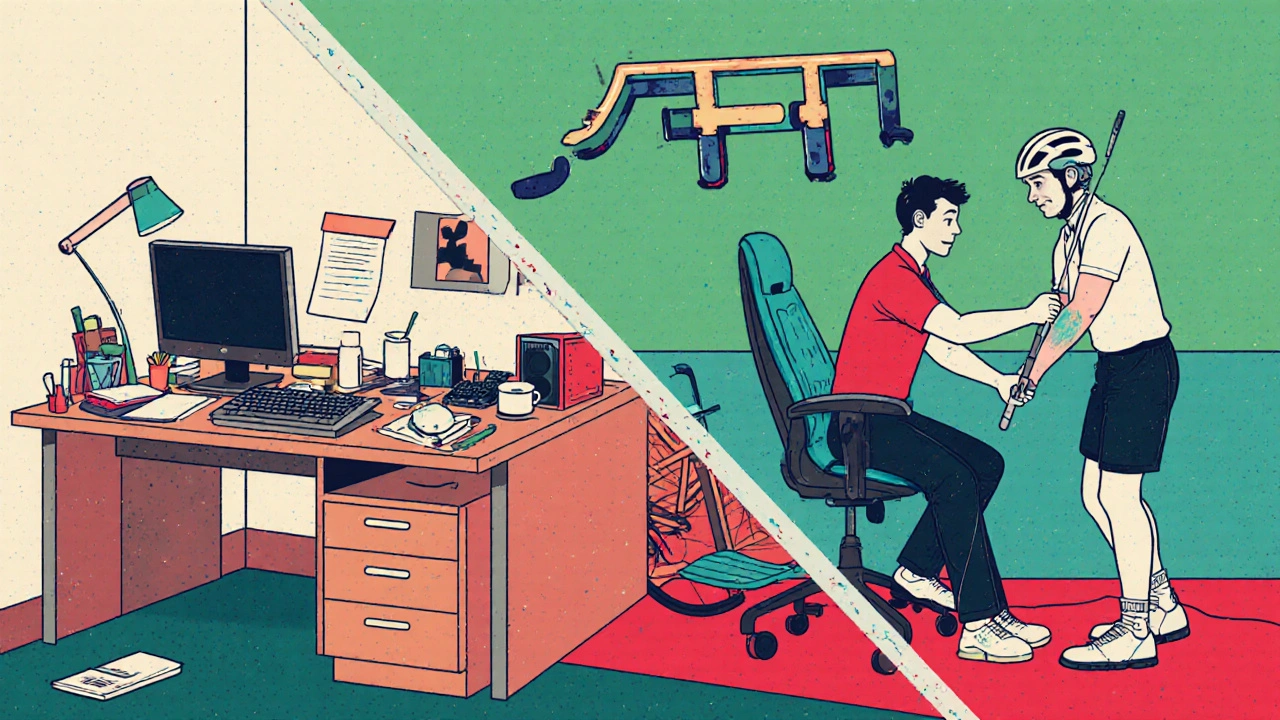Joint Strain Risk Assessment Tool
Answer these questions to determine your risk level for joint damage from repetitive activities. This assessment is based on guidelines from the article on preventing joint damage from repetitive strain injuries.
Your risk assessment will appear here after clicking the Calculate button.
Ever feel a twinge after hours at the keyboard or a long day of hunting for the perfect swing on the golf course? Those tiny aches can turn into joint damage the wear and tear that weakens cartilage, reduces synovial fluid lubrication, and can eventually lead to chronic pain or osteoarthritis if you keep ignoring the warning signs. The good news? You don’t need a miracle cure-just a solid plan that mixes smart ergonomics, targeted movement, and a few lifestyle tweaks. Below is a step‑by‑step guide to keep your joints safe while you keep doing what you love.
What Causes Joint Damage in Repetitive Strain?
Repetitive strain injuries (RSIs) are less about a single mishap and more about tiny, cumulative stresses that pile up over weeks, months, or even years. When you repeat the same motion-typing, scrolling, gripping a tool-micro‑injuries can develop in the tendons, ligaments, and especially the cartilage that cushions your joints. Over time, this leads to inflammation, reduced range of motion, and the dreaded joint degeneration.
Key players in this process include:
- Cartilage a tough, flexible tissue that absorbs shock and allows smooth joint movement
- Synovial Fluid the lubricating liquid inside joint capsules that reduces friction
- Repetitive Strain Injury a collection of musculoskeletal disorders caused by repetitive motion, forceful exertions, or awkward postures
Understanding these components helps you spot the early signs-stiffness after a workout, a dull ache that eases with rest, or a clicking sound when you move a joint.
Assess Your Risk: Simple Self‑Check
Before you overhaul your setup, run a quick self‑assessment. Answer these questions honestly:
- Do you feel soreness in the same joint after each work session? (e.g., wrist, elbow, shoulder)
- Is the pain worse after prolonged periods of inactivity (like watching TV) as well as activity?
- Do you notice a decrease in flexibility or a 'tight' feeling?
- Have you ever required a break because of hand or arm fatigue?
If you answered “yes” to two or more, it’s time to act. The next steps focus on reducing strain before it cracks the cartilage.
Ergonomic Tweaks That Make a Real Difference
Small changes to your work or sport environment can shave off a lot of joint stress. Here’s a quick “ergonomic audit” you can do in under ten minutes:
- Keyboard & Mouse Height: Keep elbows at a 90‑degree angle, forearms parallel to the floor. Use a negative‑tilt keyboard tray if needed.
- Screen Position: Top of the monitor should be at eye level; this prevents neck and shoulder forward‑leaning.
- Tool Grip: Choose handles that fit your palm comfortably; oversized grips reduce the need for extra grip force.
- Foot Support: A footrest or ergonomic chair with lumbar support encourages a neutral spine, indirectly protecting hip and knee joints.
Consider a professional Ergonomic Assessment a systematic review of workplace layout and posture to identify risk factors for musculoskeletal injury if you’re unsure where to start.

Exercise Strategies to Protect Joints
Movement is medicine, but the right kind of movement. Aim for a balanced routine that improves strength, flexibility, and joint stability without overloading the tissues.
Below is a quick reference for low‑impact versus high‑impact exercises. Low‑impact moves safeguard the joint surface while still building muscle; high‑impact activities can be useful for bone density but should be limited if you have early joint wear.
| Category | Examples | Primary Benefits | Joint Stress Level (1‑5) |
|---|---|---|---|
| Low‑Impact | Swimming, Cycling, Elliptical, Yoga | Improves cardiovascular health, strengthens stabilizing muscles | 1 |
| High‑Impact | Running, Jump Rope, HIIT Plyometrics | Boosts bone density, elevates metabolic rate | 3‑4 (avoid if cartilage thinning) |
Incorporate these core elements into your weekly plan:
- Strength Training resistance work that builds muscle around joints, reducing load on cartilage - focus on rotator cuff, forearm flexors, and gluteal muscles. 2‑3 sessions of 8‑12 reps work well.
- Stretching Routine dynamic stretches before activity and static stretches afterward to maintain joint range of motion - spend 5‑10 minutes on each major joint group.
- Balance & Proprioception Drills exercises like single‑leg stands or wobble‑board work that improve joint awareness and reduce mis‑alignment injuries - short 2‑minute bouts daily.
Consistency beats intensity. Even 15 minutes a day of targeted work can dramatically cut cumulative joint stress.
Nutrition and Lifestyle Support
What you eat fuels how well your joints repair themselves. An Anti‑Inflammatory Diet a nutrition plan rich in omega‑3 fatty acids, antioxidants, and low‑glycemic foods that reduces systemic inflammation can slow cartilage breakdown.
Key nutrients:
- Omega‑3s: Salmon, sardines, chia seeds - help dampen joint inflammation.
- Vitamin D & Calcium: Fortified dairy or plant milks - support bone health which indirectly protects joints.
- Collagen Peptides: Supplementing 10g daily may improve cartilage matrix quality (studies show modest benefit).
- Turmeric (Curcumin): 500mg twice daily can lower C‑reactive protein levels, a marker of inflammation.
Hydration also matters. Synovial fluid is mostly water, so aim for at least 2L of fluid a day, especially around workouts.

When to Seek Professional Help
If pain persists beyond a week of rest, or you notice swelling, locking, or significant loss of motion, book an appointment. Professionals who can diagnose and treat early joint damage include:
- Physical Therapist a clinician trained to assess movement patterns and prescribe therapeutic exercises
- Occupational Therapist focuses on adapting work or daily activities to reduce strain on joints
- Sports Medicine Physician medical doctor specializing in musculoskeletal injuries, capable of ordering imaging and recommending interventions
Treatment options may range from targeted braces (e.g., wrist splints) to minimally invasive injections that reduce inflammation. Early intervention is often the difference between temporary discomfort and long‑term degeneration.
Monitoring Progress and Adjusting Your Plan
Keep a simple log. Note the joint(s) affected, activity performed, duration, pain level (0‑10), and any relief measures used. Review the log every two weeks and ask yourself:
- Is pain decreasing?
- Do I feel stronger or more flexible?
- Are any activities still causing flare‑ups?
When you spot patterns, tweak your ergonomics or swap a high‑impact workout for a low‑impact alternative. The goal isn’t to eliminate all activity-just to make it joint‑friendly.
Frequently Asked Questions
Can I completely prevent joint damage from repetitive tasks?
You can’t guarantee zero risk, but combining proper ergonomics, balanced exercise, and anti‑inflammatory nutrition can reduce the likelihood of serious damage by up to 60% according to recent occupational health studies.
How long should I rest a sore joint before moving again?
A good rule is the 20‑20‑20 method: rest the joint for 20 minutes, perform gentle range‑of‑motion stretches for 20 seconds, and repeat every two hours during prolonged activity.
Are braces helpful for preventing joint wear?
A well‑fitted brace can off‑load up to 30% of joint stress during repetitive motion, but it should be used as a supplement to, not a replacement for, ergonomic improvements and strength training.
What’s the best supplement for cartilage health?
Glucosamine‑chondroitin complexes have the strongest evidence for modest cartilage preservation, especially when combined with omega‑3 fish oil.
Is yoga suitable for someone with early joint pain?
Yes-gentle yoga emphasizes controlled movement and stretching, which can improve joint lubrication and reduce stiffness. Choose classes that avoid deep knee bends or extreme wrist extensions if those areas are sensitive.


Write a comment